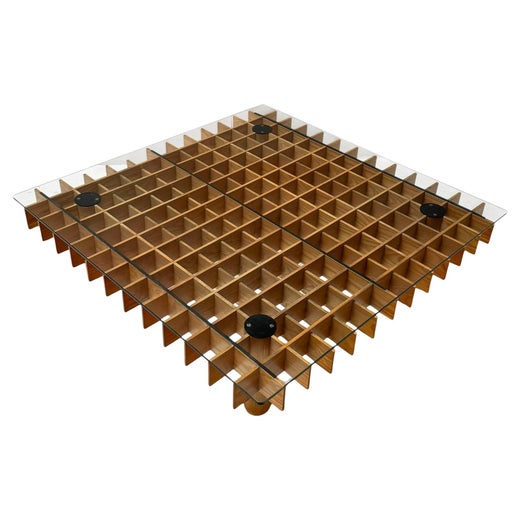Armchair by Ico Parisi, Gio Ponti, Gianfranco Frattini
About the Item
- Creator:
- Dimensions:Height: 31.89 in (81 cm)Width: 34.65 in (88 cm)Depth: 26.19 in (66.5 cm)
- Materials and Techniques:
- Place of Origin:
- Period:
- Date of Manufacture:1954
- Condition:Wear consistent with age and use. 66,5 x 88-106 x back h 81-102 cm.
- Seller Location:Milan, IT
- Reference Number:Seller: 43641stDibs: LU106181715992
Gio Ponti
An architect, furniture and industrial designer and editor, Gio Ponti was arguably the most influential figure in 20th-century Italian modernism.
Ponti designed thousands of furnishings and products — from cabinets, mirrors and chairs to ceramics and coffeemakers — and his buildings, including the brawny Pirelli Tower (1956) in his native Milan, and the castle-like Denver Art Museum (1971), were erected in 14 countries. Through Domus, the magazine he founded in 1928, Ponti brought attention to virtually every significant movement and creator in the spheres of modern art and design.
The questing intelligence Ponti brought to Domus is reflected in his work: as protean as he was prolific, Ponti’s style can’t be pegged to a specific genre.
In the 1920s, as artistic director for the Tuscan porcelain maker Richard Ginori, he fused old and new; his ceramic forms were modern, but decorated with motifs from Roman antiquity. In pre-war Italy, modernist design was encouraged, and after the conflict, Ponti — along with designers such as Carlo Mollino, Franco Albini, Marco Zanuso — found a receptive audience for their novel, idiosyncratic work. Ponti’s typical furniture forms from the period, such as the wedge-shaped Distex chair, are simple, gently angular, and colorful; equally elegant and functional. In the 1960s and ’70s, Ponti’s style evolved again as he explored biomorphic shapes, and embraced the expressive, experimental designs of Ettore Sottsass Jr., Joe Colombo and others.
Ponti's signature furniture piece — the one by which he is represented in the collections of the Museum of Modern Art in New York, Germany’s Vitra Design Museum and elsewhere — is the sleek Superleggera chair, produced by Cassina starting in 1957. (The name translates as “superlightweight” — advertisements featured a model lifting it with one finger.)
Ponti had a playful side, best shown in a collaboration he began in the late 1940s with the graphic artist Piero Fornasetti. Ponti furnishings were decorated with bright finishes and Fornasetti's whimsical lithographic transfer prints of things such as butterflies, birds or flowers; the Montreal Museum of Fine Arts possesses a 1950 secretary from their Architetturra series, which feature case pieces covered in images of building interiors and facades. The grandest project Ponti and Fornasetti undertook, however, lies on the floor of the Atlantic Ocean: the interiors of the luxury liner Andrea Doria, which sank in 1956.
Widely praised retrospectives at the Queens Museum of Art in 2001 and at the Design Museum London in 2002 sparked a renewed interest in Ponti among modern design aficionados. (Marco Romanelli’s monograph, which was written for the London show, offers a fine overview of Ponti’s work.) Today, a wide array of Ponti’s designs are snapped up by savvy collectors who want to give their homes a touch of Italian panache and effortless chic.
Find a range of vintage Gio Ponti desks, dining chairs, coffee tables and other furniture on 1stDibs.
Gianfranco Frattini
Gianfranco Frattini is widely regarded as a mid-century master of Italian modern design. He was an award-winning architect and designer, and specialized in creating furniture and decor that is both decorative and practical — Frattini’s vintage desks, armchairs, nesting tables and other works are celebrated for their sophisticated merging of function and form.
Born in Padua in 1926, Frattini studied architecture at the Polytechnic University of Milan. He later apprenticed with his teacher and mentor, Gio Ponti. Through Ponti — arguably the most important figure in 20th-century Italian architecture and design — Frattini met many notable modernist designers such as Oscar Niemeyer and Le Corbusier, but an introduction to famed Italian entrepreneur Cesare Cassina would prove incredibly significant in helping launch his career.
During the mid-1950s, Frattini began to collaborate with Cassina’s eponymous company. He designed the brand’s acclaimed leather and walnut Model 849 lounge chair — a winner of the Compasso d’Oro award — the Marema nesting tables and the iconic Sesann collection. The latter, an enduring 1970s suite of impossibly welcoming leather-covered seating, is now produced by Tacchini. In addition to Cassina, Frattini created furniture and lighting for other manufacturers such as Bernini, Arteluce, Artemide, Knoll and more.
While many of his designs incorporate glass, tubular steel and other materials, Frattini loved working with wood. The sculptural Albero bookcase — an innovative floor-to-ceiling structure made in walnut that swings on a 360-degree vertical swivel axis — is a striking example of Frattini’s dedication to traditional woodworking techniques. In the early 1970s, he traveled to Japan with friend and collaborator Pierluigi Ghianda — a master Milanese cabinet maker — in order to study the work of artisans in Kyoto. The trip inspired his design of the Kyoto table, a work of solid beech with Canaletto walnut inserts that is part of the permanent collection of the Milan Triennale’s Design Museum. The Kyoto and Albero have been revived by Poltrona Frau.
Frattini’s designs are in the permanent collections of prestigious museums such as the Museum of Modern Art and the Cooper Hewitt, Smithsonian Design Museum.
Find vintage Gianfranco Frattini furniture, lighting and decor on 1stDibs.
You May Also Like
Vintage 1950s Italian Modern Ottomans and Poufs
Iron
2010s Italian Mid-Century Modern Armchairs
Metal
2010s Italian Mid-Century Modern Armchairs
Metal
2010s Italian Mid-Century Modern Armchairs
Metal
Vintage 1950s Italian Mid-Century Modern Armchairs
Fabric, Wood
Vintage 1970s Italian Armchairs
Chrome
2010s Italian Armchairs
Leather, Fabric
2010s Italian Armchairs
Leather, Fabric
Mid-20th Century Mid-Century Modern Armchairs
Bamboo, Cane
2010s Italian Armchairs
Leather, Fabric
Recently Viewed
View AllRead More
Billy Cotton Layers His Interiors with Lived-In Comfort
The Brooklyn-based designer is adept at styles ranging from austere to over-the-top, espousing an architectural, detail-oriented approach also evident in his line of furniture and lighting.
Italian Design Legend Giò Ponti Makes a Splash in Paris
A blockbuster exhibition at the Musée des Arts Décoratifs shows the work of the modernist master in a brilliant new light.

